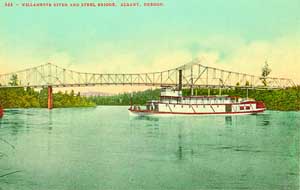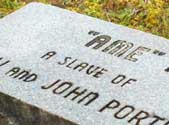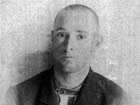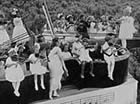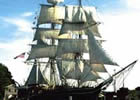Missing gold suggests something sinister in shipwreck mystery
There were, so far as we know, no survivors. But when the upside-down hulk drifted ashore, it was 200 miles off course — and there was no sign of the 40-pound keg of gold it had been carrying. What happened? Nobody knows.

This photo, from around 1900, is of the three-masted schooner
Wawona, launched in 1897, originally a lumber schooner like the
Sunshine. (Photo: Northwest Seaport, Seattle) [Larger image: 1200 x
820 px] [Information page about the Wawona]
By Finn J.D. John — December 4, 2011
In October of 1875, a brand-new schooner sailed out of San Francisco Bay, on her way to her home port of Coos Bay. Twenty-five passengers and crew were on board.
Neither people nor ship was ever heard from again — until a month later, when the lifeless, upside down hull of the ship washed ashore.
And the persistent, unanswered question is … did somebody do this on purpose?
A shipbuilding triumph
The Sunshine was a 325-ton three-masted schooner — a big ship for that age. She was built at a cost of $32,000 by the Holden & Co. shipyard in Coos Bay — then called “Marshfield” — in September of 1875. Her owners wasted no time putting her to work; soon she was beating out to sea on her maiden voyage, bound for San Francisco with a load of lumber.
When the Sunshine left port for the first time, she was skippered by one George Bennett, an experienced captain who was also part owner of the ship. His officers included two other highly respected, very competent mariners.
Upon arrival at San Francisco, the new ship unloaded its lumber and took on cargo for the return trip: Some machinery, a small cohort of passengers, and $10,000 in gold.
It’s the passengers and the gold that make this story especially interesting. For what happened after the Sunshine sailed through the Golden Gate and out into the wide Pacific is a complete mystery. No one survived to tell about it — as far as we know.
No sign of the gold or the crew
For over a month, nothing was heard from the new schooner. Then she was spotted — floating bottom-side-up off Cape Disappointment on the north side of the Columbia River. After a while, the wreck washed ashore on Peacock Spit.
An upside-down schooner isn’t easy to live on, so it wasn’t surprising that there were no survivors on board. What was more surprising, though, was the absence of the $10,000 in gold. Then, as now, this was hard to explain. Ships don’t capsize gradually; it’s all done in an instant, and survivors are left with a barnacle-covered hulk with waves breaking over it and no way to get in or out. Something like that doesn’t happen on a calm day, on which there’s plenty of time to think about things like 40-pound kegs of gold that are scheduled to be delivered to somebody else. So if the ship met its end in heavy weather, it’s probably safe to assume nobody went and fetched the gold as the vessel was being abandoned.
But if that’s the case, how did the gold end up missing? Kegs of gold do not get left lying around on deck, where they can fall off into the sea in the event of capsize. They’re kept below decks, in secure and secret locations — closed rooms, locked cabinets, places like that. Places that, when turned upside down, don’t usually release their contents into the ocean.
Suspiciously off course
By itself, the curious absence would be enough to raise an eyebrow or two. But what’s really puzzling about the Sunshine is the place in which it was found. Remember, the ship left San Francisco bound for Coos Bay. So, what was it doing washing ashore on the south coast of Washington state? Winds and currents could hardly have carried it 200 miles north and zero miles east in a few weeks — not in Oregon where the wind comes always out of the southwest, and certainly not in November. What was the Sunshine doing puttering around Tillamook and Astoria?
Rumors of foul play
Stories started circulating almost at once. The least believable of these involved a rumored landing north of Coos Bay, during which the ship’s officers buried the keg of gold and set off northward afterward. Perhaps they were planning on taking the ship far away, scuttling it, rowing ashore and claiming to have just survived a shipwreck, then slipping back to the beach and digging their booty up later. Perhaps they were making for Canada. Who knows?
This theory inspired a number of people to go out treasure-hunting in the sands north of Coos Bay. It likely won’t surprise you to learn that nothing was ever found there.
The other story is just as speculative, but it’s less specific. The idea is that a group of the passengers, knowing the ship carried a cargo of gold, hijacked the ship and sailed beyond Coos Bay to some unknown location on the north coast of Oregon. There, they loaded the booty in a lifeboat, killed everybody else aboard ship, and rowed ashore in the middle of the night with the loot.
Well, OK, it fits the evidence. But there’s so little evidence, almost anything would fit it — sea monsters, pirates from Mexico, alien abduction, you name it. The bottom line is, we have no idea what happened to the people on board, and we don’t know where the gold went.
There’s a lot we don’t know about the demise of the Sunshine. And there’s certainly not enough evidence to declare definitively that foul play was involved. But it sure can’t be ruled out.
(Sources: Gibbs, James A. Jr. Pacific Graveyard. Portland: Binford, 1950; Wright, E.W. Lewis and Dryden’s Marine History of the Pacific Northwest. Portland: Lewis and Dryden, 1895; www.cimorelli.com/magellan)
TAGS: #MYSTERIES: #lost #xTheories #treasure :: #EVENTS: #shipwrecks #fatal :: # #marine #mystery :: LOC: #offshore :: #158






